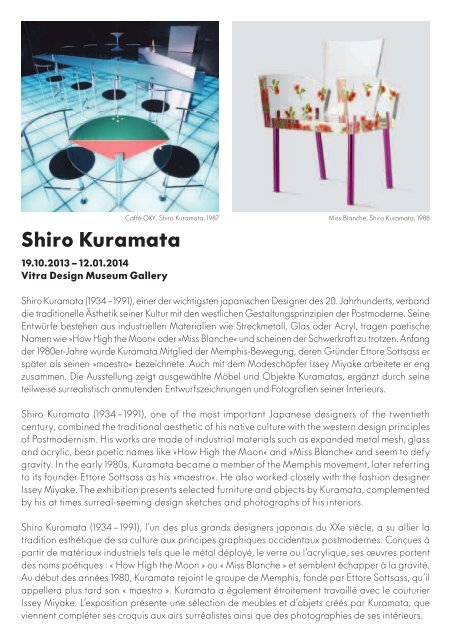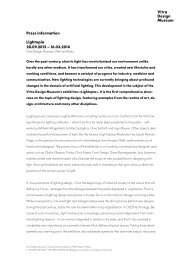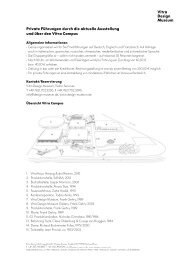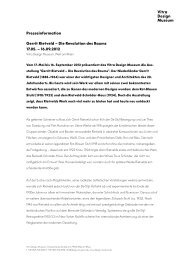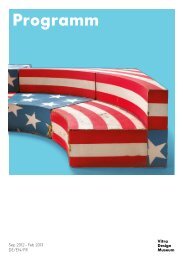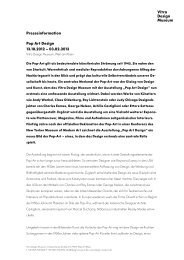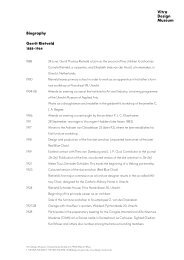Lightopia Programm - Vitra Design Museum
Lightopia Programm - Vitra Design Museum
Lightopia Programm - Vitra Design Museum
Create successful ePaper yourself
Turn your PDF publications into a flip-book with our unique Google optimized e-Paper software.
Shiro Kuramata<br />
19.10.2013 – 12.01.2014<br />
<strong>Vitra</strong> <strong>Design</strong> <strong>Museum</strong> Gallery<br />
Caffé OXY, Shiro Kuramata, 1987 Miss Blanche, Shiro Kuramata, 1988 Dispatchwork Quito – using Lego bricks, Jan Vormann, 2009 New Kintsugi repair kit by Humade – a new way of gluing porcelain, 2010<br />
Repair!<br />
18.01. – 02.02.2014<br />
<strong>Vitra</strong> <strong>Design</strong> <strong>Museum</strong> Gallery<br />
Shiro Kuramata (1934 – 1991), einer der wichtigsten japanischen <strong>Design</strong>er des 20. Jahrhunderts, verband<br />
die traditionelle Ästhetik seiner Kultur mit den westlichen Gestaltungsprinzipien der Postmoderne. Seine<br />
Entwürfe bestehen aus industriellen Materialien wie Streckmetall, Glas oder Acryl, tragen poetische<br />
Namen wie »How High the Moon« oder »Miss Blanche« und scheinen der Schwerkraft zu trotzen. Anfang<br />
der 1980er-Jahre wurde Kuramata Mitglied der Memphis-Bewegung, deren Gründer Ettore Sottsass er<br />
später als seinen »maestro« bezeichnete. Auch mit dem Modeschöpfer Issey Miyake arbeitete er eng<br />
zusammen. Die Ausstellung zeigt ausgewählte Möbel und Objekte Kuramatas, ergänzt durch seine<br />
teilweise surrealistisch anmutenden Entwurfszeichnungen und Fotografien seiner Interieurs.<br />
Shiro Kuramata (1934 – 1991), one of the most important Japanese designers of the twentieth<br />
century, combined the traditional aesthetic of his native culture with the western design principles<br />
of Postmodernism. His works are made of industrial materials such as expanded metal mesh, glass<br />
and acrylic, bear poetic names like »How High the Moon« and »Miss Blanche« and seem to defy<br />
gravity. In the early 1980s, Kuramata became a member of the Memphis movement, later referring<br />
to its founder Ettore Sottsass as his »maestro«. He also worked closely with the fashion designer<br />
Issey Miyake. The exhibition presents selected furniture and objects by Kuramata, complemented<br />
by his at times surreal-seeming design sketches and photographs of his interiors.<br />
Shiro Kuramata (1934 – 1991), l’un des plus grands designers japonais du XXe siècle, a su allier la<br />
tradition esthétique de sa culture aux principes graphiques occidentaux postmodernes. Conçues à<br />
partir de matériaux industriels tels que le métal déployé, le verre ou l’acrylique, ses œuvres portent<br />
des noms poétiques : « How High the Moon » ou « Miss Blanche » et semblent échapper à la gravité.<br />
Au début des années 1980, Kuramata rejoint le groupe de Memphis, fondé par Ettore Sottsass, qu’il<br />
appellera plus tard son « maestro ». Kuramata a également étroitement travaillé avec le couturier<br />
Issey Miyake. L’exposition présente une sélection de meubles et d’objets créés par Kuramata, que<br />
viennent compléter ses croquis aux airs surréalistes ainsi que des photographies de ses intérieurs.<br />
2010 veröffentlichte die niederländische Initiative Platform 21 das »Repair Manifesto«, beginnend<br />
mit dem Slogan »Stop Recycling. Start Repairing«. Sie beschrieb damit einen Gegenentwurf zur<br />
Wegwerfgesellschaft, in der schneller gekauft als geflickt wird. Seitdem beschäftigen sich auch<br />
<strong>Design</strong>er, Theoretiker und Alltagsnutzer mit der neuen Kultur des Reparierens – sie ist keine<br />
Notlösung mehr, sondern kulturelle und ökonomische Praxis. Die experimentelle Ausstellung<br />
»Repair!« entsteht als Ergebnis einer Performance zur <strong>Museum</strong>snacht Basel, bei der Besucher<br />
eigene Objekte ins <strong>Museum</strong> bringen und mit Profis reparieren können. Die besten Stücke werden<br />
ausgestellt – machen Sie mit!<br />
In 2010, the Dutch initiative Platform 21 published the so-called »Repair Manifesto«, beginning<br />
with the slogan »Stop Recycling. Start Repairing«. It proposed a counter-model to today’s throwaway<br />
society, which is quicker to discard and buy new than to mend and keep. <strong>Design</strong>ers, theorists and<br />
everyday consumers have since increasingly explored the new culture of repairing – it is no longer<br />
seen as a second-best emergency solution, but as a valid cultural and economic practice.<br />
The experimental exhibition »Repair!« is the outcome of a performance forming part of Basel<br />
<strong>Museum</strong>s Night, during which visitors can bring objects to the museum and repair them with the<br />
help of professionals. The best solutions become part of the exhibition. Join in!<br />
En 2010, l’initiative néerlandaise Platform 21 a publié son « Repair Manifesto », qui a pour slogan<br />
« Stop Recycling. Start Repairing ». Le projet se place en opposition à la société du jetable, où l’on<br />
choisit de racheter plutôt que de réparer. Depuis, les designers, théoriciens et utilisateurs se sont<br />
intéressés à cette nouvelle culture de la réparation, qui n’est plus une solution de secours mais une<br />
véritable pratique culturelle et économique. L’exposition expérimentale « Repair! » est le fruit d’une<br />
performance de la nuit des musées de Bâle, au cours de laquelle les visiteurs ont la possibilité<br />
d’apporter des objets personnels et de les réparer avec l’aide de professionnels. Les meilleures<br />
pièces sont exposées – participez !<br />
07


